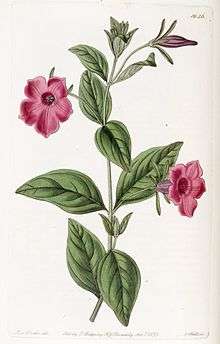Petunia integrifolia
Petunia integrifolia and Petunia violacea have both been known by the vernacular name of violet petunia[3] or violetflower petunia,[4] both being species of wild petunia with violet-colored blooms.[5][6] Petunia integrifolia is native to Argentina.[7] P. integrifolia bears flowers approximately 1.5 inch in diameter and the plant is typically smaller and harder to cultivate than the well-known hybrid bedding Petunia now known correctly as Petunia × atkinsiana.[8][9]
| Petunia integrifolia | |
|---|---|
 | |
| Illustration from Edwards's Botanical Register, 1833 | |
| Scientific classification | |
| Kingdom: | Plantae |
| Clade: | Tracheophytes |
| Clade: | Angiosperms |
| Clade: | Eudicots |
| Clade: | Asterids |
| Order: | Solanales |
| Family: | Solanaceae |
| Genus: | Petunia |
| Species: | P. integrifolia |
| Binomial name | |
| Petunia integrifolia | |
| Synonyms[2] | |
| |
Petunia integrifolia and P. violacea are two out of 21 accepted species of Petunia.[10]
Taxonomy
The species was first described as Salpiglossis integrifolia by William Jackson Hooker in 1831.[11] It was transferred to the genus Petunia as P. integrifolia by Hans Schinz and Albert Thellung in 1915.[12] Petunia violacea, described by John Lindley in 1833, was formerly considered a synonym, but is now held to belong to a different, accepted species . Petunia inflata has sometimes been considered to be part of the P. integrifolia species, but the two have different native ranges, with P. inflata growing in more northern areas.[13]
Hallucinogen
Petunia violacea Lindl. has been reported to be used as a hallucinogen in Ecuador, where the plant has the vernacular name shanín. The drug is said to cause sensations of levitation and flight - a type of hallucination often associated with the use of the more toxic hallucinogenic plants of the deliriant type e.g. the tropane-containing Atropa and Hyoscyamus - active constituents of the witches' flying ointments of Medieval and Early Modern Europe. [14] [15]
References
- Nowick, Elaine (1 October 2014). Historical Common Names of Great Plains Plants, Volume I: Common Names. Lincoln, NE: Lulu.com. p. 437. ISBN 978-1-60962-058-5.
- "Tropicos.org". Retrieved 13 September 2015.
- Nowick, Elaine (1 October 2014). Historical Common Names of Great Plains Plants, Volume I: Common Names. Lincoln, NE: Lulu.com. p. 437. ISBN 978-1-60962-058-5.
- "Petunia integrifolia". Natural Resources Conservation Service PLANTS Database. USDA. Retrieved 23 September 2015.
- ITIS on-line database (1996). "Petunia integrifolia". U.S. Geological Survey. Integrated Taxonomic Information System. Retrieved 12 September 2015.
- Michelle Wishhart. "Petunia Violacea plants". Demand Media. Retrieved 12 September 2015.
- "Heirloom Garden: What's Blooming in Autumn?". Smithsonian Gardens. Retrieved 12 September 2015.
- Quentin Groom (2011). "Petunia integrifolia". Retrieved 12 September 2015.
- "Petunia (group)". Missouri Botanical Garden. Retrieved 12 September 2015.
- The Plant List : Petunia http://www.theplantlist.org/tpl1.1/search?q=Petunia Retrieved 00.38 on 16/3/19.
- William Jackson Hooker (1831), "Plate 3113 and two pages of descriptive text", Curtis's botanical magazine, Volume 5 (new series) = volume 58
- Hans Schinz (1915), "Petunia integrifolia in Mitteilungen aus dem botanischen Museum der Universität Zürich (LXXI.)", Vierteljahrsschrift der Naturforschenden Gesellschaft in Zürich, 60, p. 361
- Ando, T.; Ishikawa, N.; Watanabe, H.; Kokubun, H.; Yanagisawa, Y.; Hashimoto, G.; Marchesi, E.; Suárez, E. (2005), "A Morphological Study of the Petunia integrifolia Complex (Solanaceae)", Annals of Botany, 96 (5): 887–900, doi:10.1093/aob/mci241, PMC 4247055, PMID 16103037
- Schultes, Richard Evans Hallucinogenic Plants a Golden Guide, pub. Golden Press N.Y., 1976, Library of Congress Catalog Card Number : 74-21666, page 150.
- Haro, A., S. L. : "Shamanismo y farmacopea en el Reino de Quito". Inst. Ecuat. Cienc. Nat. Contr., No. 75 : Nov. 1971.
External links


- P. integrifolia's entry at Gardenguides.com